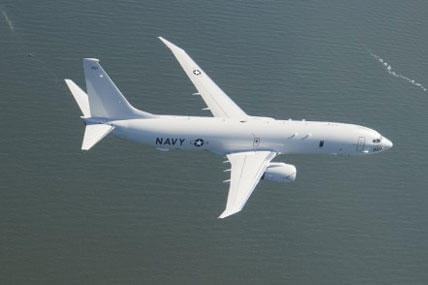The U.S. Navy's new maritime patrol aircraft has joined the search for a missing Malaysian airliner despite recent criticism over its ability to conduct wide-area surveillance.
A spokesman for the service's Seventh Fleet, based in Yokosuka, Japan, on Thursday said the P-8A Poseidon, made by Boeing Co., is helping to look for Malaysia Airlines Flight 370. The commercial airliner went missing March 8 about an hour after taking off from Kuala Lumpur International Airport on a flight to Beijing.
The twin-engine jet, a military version of the Boeing 737-800, joins its predecessor, the propeller-driven P-3C Orion made by Lockheed Martin Corp., and other aircraft and ships in a widening international response. The patrol plane's long range was a factor as operations may expand to the Indian Ocean amid reports that the airliner could have flown for hours after its final communication.
"This move adds the P-8's enhanced technology and greater range to the search efforts while maximizing planned maintenance and guarding against air crew fatigue for both aircraft," Cmdr. William Marks, a spokesman for the fleet, told The Wall Street Journal.
The Navy reportedly plans to fly the P-8 and the P-3 on a daily rotation in search of Flight 370, according to the article.
With a maximum range of 1,200 nautical miles, the Poseidon could scan an area for four hours before having to turn back, the article stated. While it can fly as fast as 563 miles per hour and climb as high as 41,000 feet, the plane will typically fly under 10,000 feet at about 400 miles per hour and search for several hours, depending on the distance to the site, it stated.
The article indicates the Poseidon has a greater range than the Orion, though Navy information files state the latter has a maximum range of almost 2,400 nautical miles, or double that of the P-8.
The P-8's advantages over the P-3 in radar and sensor technology aren't clear. A spokeswoman for the Navy wasn't immediately able to explain how the aircraft was being used in the search operations.
The Defense Department's top weapons tester, J. Michael Gilmore, recently said the aircraft can perform some missions such as small-area surveillance, but not primary missions such as hunting submarines or conducting broad-area surveillance, due in part to "sensor shortfalls."
"The P-8A is not effective for the Intelligence, Surveillance, and Reconnaissance (ISR) mission," the report states. "Radar performance deficiencies, sensor integration problems, and data transfer system interoperability shortfalls degrade imagery intelligence collection and dissemination capabilities."
A Boeing official, who asked to be unnamed to speak freely about the document, said many of the issues identified were related to software that has since been fixed. In addition, the testing was done more than a year ago and doesn't reflect recent positive feedback from operators in the field, the individual said.
The Navy in recent months stationed six P-8s at the Naval Air Facility Atsugi, Japan, as part of the so-called shift in strategic emphasis to the Asia-Pacific region. One of these is presumed to be the aircraft searching for the Malaysian airliner.
Vice Adm. Robert Thomas, commander of Seventh Fleet, has said he was impressed with the aircraft after flying in one over Japan as part of their inaugural deployment. His comments also contradicted the findings of the test report.
"Across every mission set, from Anti-Submarine Warfare to Intelligence, Surveillance and Reconnaissance, P-8A capability represents a significant improvement over the P-3C, providing the opportunity to detect, track and report on more targets than ever before," he said in an official news release.
The Navy plans to buy a total of 122 of the aircraft, including five test versions and 117 production models, at an estimated cost of $35 billion. The latest agreement with Boeing brings the number of planes on contract to 54.
(Story was updated to add information about range of P-3 in seventh paragraph.)
-- Brendan McGarry can be reached at brendan.mcgarry@monster.com






























